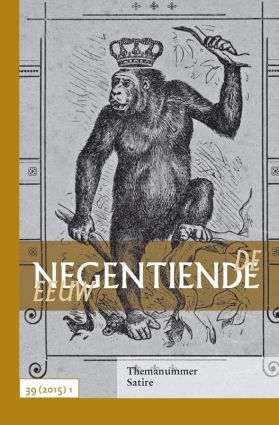Ivo NieuwenhuisDe vele gezichten van satire 1-16
Abstract (EN)
The many faces of satire.Satire is a difficult topic to study, yet also a popular one. This article intends to give an overview of the various aspects that the genre of satire entails. Discussed are satire’s parasitic nature, its tendency to rely on existing media and art forms for its mode of expression; the relation between satire and play; and the intended and unintended provocations to which satire can lead. These aspects of the satiric genre are illustrated through some cases of nineteenth-century Dutch satire, supplemented with examples from other periods and regions, including our own time. It is argued that, in the end, a topic as multifarious as satire is best served by a broad, inclusive and open research perspective.
Laurens HamAch, mijn martelaartje! J.B.D. Wibmers postures en de ruimte voor politieke kritiek rond 1820 17-41
Abstract (EN)
Oh, my little martyr! J.B.D. Wibmer’s postures and the possibilities for political criticism around 1820.In this article, the oeuvre of J.B.D. Wibmer (1792-1836) is analyzed. This hack writer published several popular magazines and pamphlets between 1818 and 1836, in which sharply satirical opinions were expressed about the protestant church and the Dutch monarchy of William I. A posture analysis of the way Wibmer plays with (fictional) author figures, pseudonymity, anonymity and sentimental style features, shows what possibilities were available for political criticism in the harsh publishing climate around 1820. However, Wibmer’s complex satirical texts cannot unproblematically function as sources for historical research, this article argues.
Frederiek ten Broeke‘Bijtende pennekras’. Satire als wapen in de politieke journalistiek, 1870-1885 62-79
Abstract (EN)
Dutch political satire in nineteenth century journalism.The last decades of the nineteenth century signified an important transitional period in the Netherlands in the formation of defined political movements. These movements aimed at the formation of national political parties and strove for a stronger connection to their (potential) electoral support. The printing press played a crucial role in these communications. Surprisingly, a striking component of the Dutch political journals has remained a neglected source in the existing historical narratives of these politically and socially influential decades: the satirical periodicals. Criticizing both their political friends and foes, they confronted the limits of public expression and defined political decorum in the public sphere. This article aims to encourage future research on this subject, focusing on the liberal satirical journals Asmodée (1854-1911) and Uilenspiegel (1870-1916) and their coverage of the conflict between liberal and confessional political parties concerning financial support for confessional education.
Boekzaal der geleerde wereld 80-94
- Inge Bertels, Jan Hein Furnée, Tom Sintobin, Hans Vandevoorde, Rob van de Schoor (red.), Tussen beleving en verbeelding. De stad in de negentiende-eeuwse literatuur. Leuven: Universitaire Pers, 2013. (Christianne Smit)
- Jaap Moes, Onder aristocraten. Over hegemonie, welstand en aanzien van adel, patriciaat en andere notabelen, 1848-1914. Hilversum: Verloren, 2012. (Elyze Storms-Smeets)
- Nelleke Teughels, ‘Mag het iets meer zijn?’ Kleine kruidenierswinkels worden big business, Delhaize
Frères & Cie (1867-1940). Leuven: Universitaire Pers, 2014. (Clé Lesger) - G.Th.A. Calkoen, Onder studenten. Leidse aanstaande medici en de metamorfose van de geneeskunde in de negentiende eeuw (1838-1888). Leiden: Ginko, 2012. (Pieter Caljé)
- Jaco Rutgers en Mieke Rijnders (red.), Rembrandt in perspectief. De veranderende visie op de meester en zijn werk. Zwolle: Open Universiteit/Waanders Uitgevers, 2014. (Marlite Halbertsma)
- Cyp Quarles van Ufford, Andreas Schelfhout (1787-1870). Landschapschilder in Den Haag. Naar eigentijdse bronnen. Leiden: Primavera Pers, 2009. (Annemiek Ouwerkerk)
- Willem de Bruin, Je moet hier zijn geweest. Oosterbeek, Nederlands eerste kunstenaarskolonie. Amsterdam: Atlas Contact, 2014. (Wiepke Loos)
- Frans Grijzenhout, Niek van Sas en Wieger Velema (red.), Het Bataafse experiment. Politiek en cultuur rond 1800. Nijmegen: Vantilt, 2013. (Peter Altena)
- Ido de Haan, Paul den Hoed en Henk te Velde (red.), Een nieuwe staat. Het begin van het Koninkrijk der Nederlanden. Amsterdam: Prometheus/Bert Bakker, 2013. (Jeroen Koch)
- Anne van Buul, In vreemde grond geworteld. Prerafaëlitisme in de Nederlandse literatuur en beeldende kunst (1855-1910). Hilversum: Verloren, 2014. (Jaap Jan Heij)

